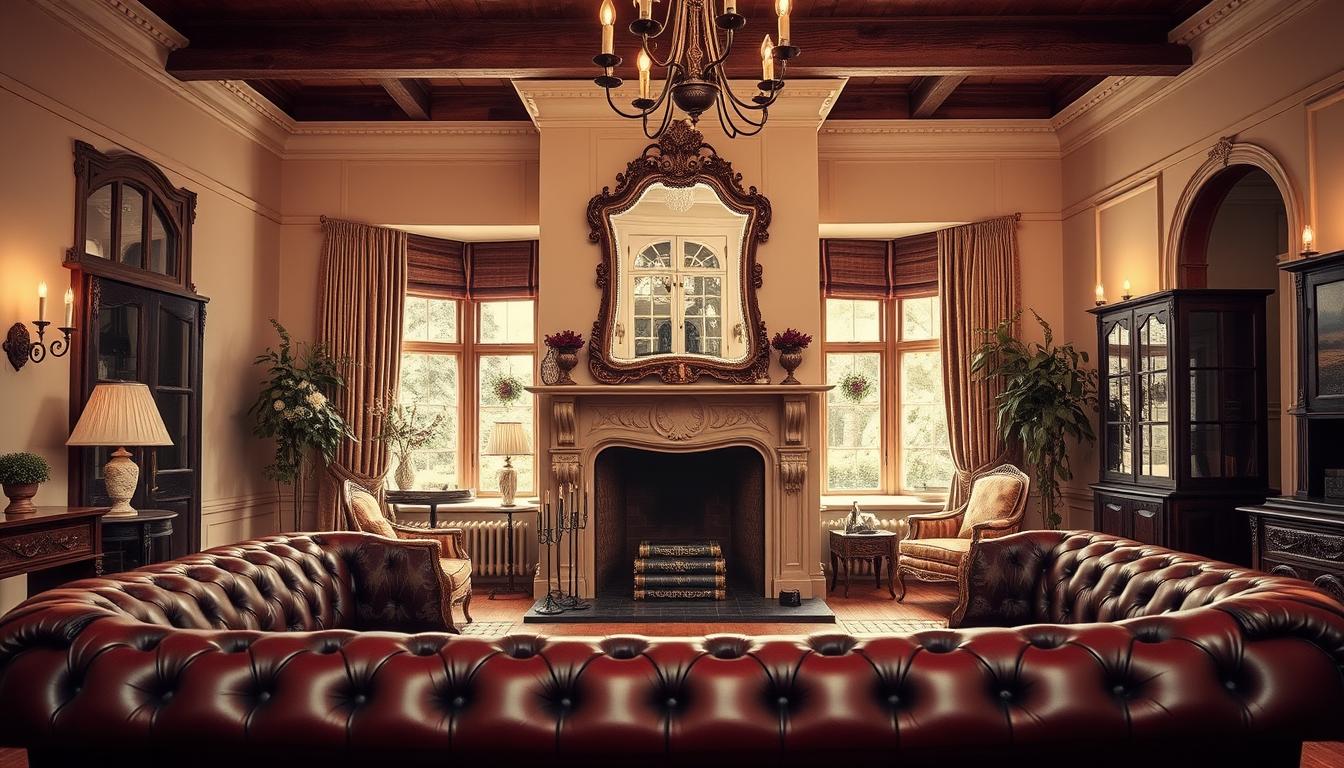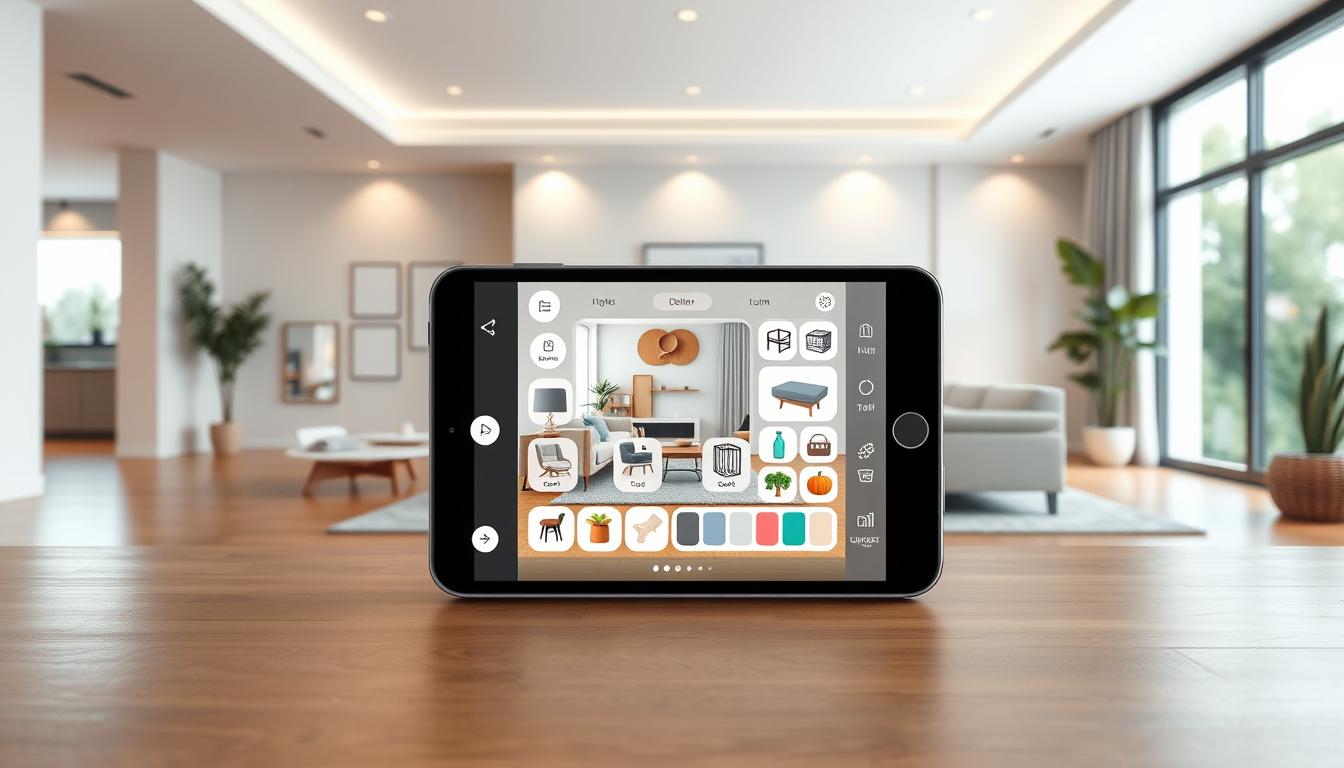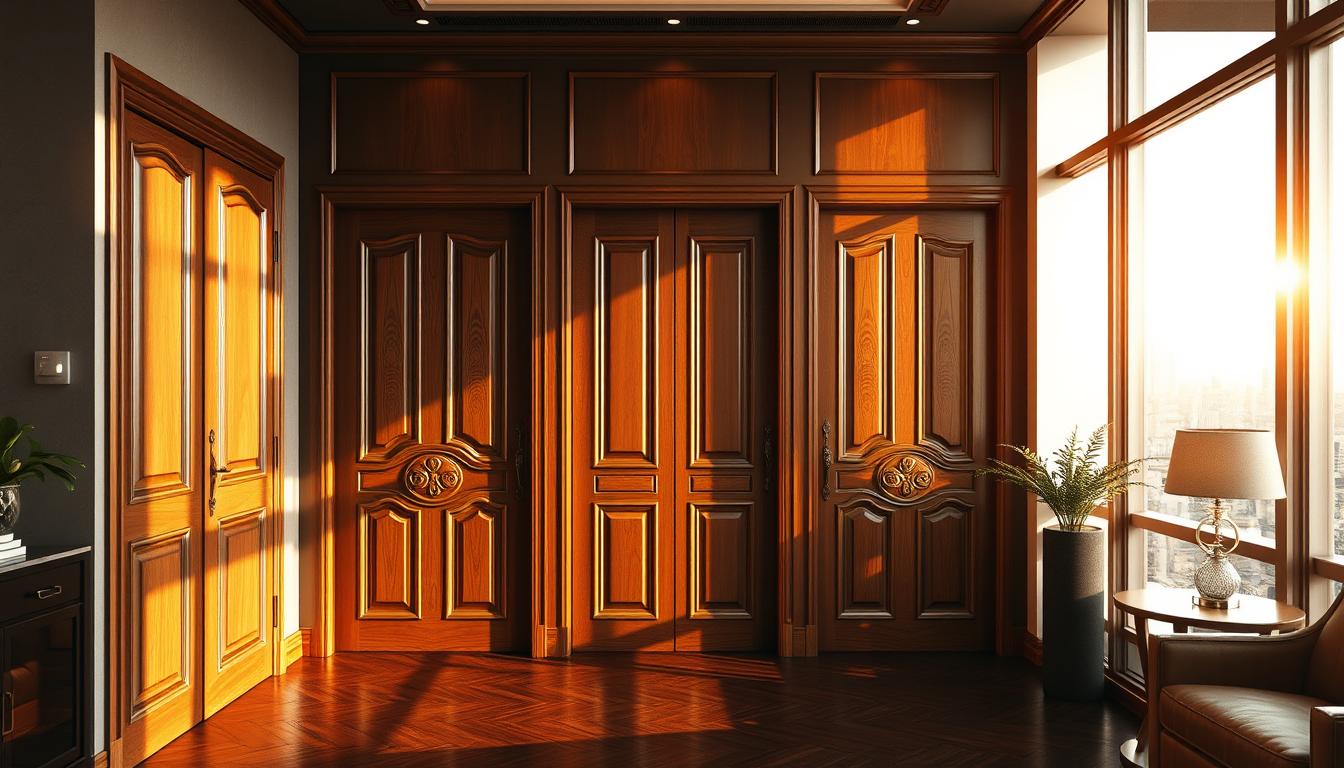Did you know homes from the 1920s are getting more popular? People love their unique look and old charm. As we dive into vintage home decor, it’s clear these homes are perfect for creativity.
This guide will help you decorate your 1920s home. We’ll show you how to mix old charm with new touches. You’ll learn about vintage home decor and how to keep your home’s original feel while adding modern pieces.
By the end of this guide, you’ll know how to update your 1920s home. You’ll keep its timeless beauty while making it modern.
Key Takeaways
- Understanding the historical significance of your 1920s home
- Identifying key architectural features to preserve
- Balancing vintage and modern elements in your decor
- Selecting furnishings that complement your home’s original style
- Tips for incorporating contemporary touches without losing the vintage charm
Understanding the 1920s Home Design Aesthetic
The 1920s home design was a mix of architectural styles and interior influences. This era saw the rise of Art Deco. It featured geometric shapes, metallic materials, and bold designs.
Homes from this time were more than just a sign of wealth. They showed a move towards modernity and away from old designs. This mix of old and new makes 1920s homes special for historic home renovation today.
Key Characteristics of 1920s Homes
1920s homes stand out with several key features:
- Geometric patterns in tile work, wallpaper, and furniture.
- Luxurious materials like marble, inlaid wood, and metallic accents.
- Bold colors, including pastels and deep, rich hues.
These features were not just pretty. They also showed off the homeowner’s status and taste.
Popular Architectural Styles
The 1920s brought back several architectural styles, including:
- Tudor Revival, known for its brick, stone, and half-timbering.
- Art Deco, with its geometric shapes and metallic materials.
- Craftsman, focusing on handcrafted details and natural materials.
These styles helped shape the 1920s architectural scene.
Influences on Interior Design
Interior design in the 1920s was shaped by the era’s cultural and economic boom. The rise of Art Deco brought a glamorous, modern look. This was seen in furniture, lighting, and decor.
“The modern decorator is now recognizing the value of the antique, and the antique dealer is beginning to see the possibilities of the modern.” –
This mix of modern and traditional is key to 1920s interior design. It’s a rich source of inspiration for today’s design projects.
Color Palettes for 1920s Interiors
To get a period-appropriate interior, knowing the 1920s color palettes is key. The 1920s saw a big change in interior design, moving towards brighter and more varied styles.
The 1920s interiors mixed earthy tones, soft pastels, and bold colors. This mix gave the era a unique look that defined retro home styling.
Emphasizing Earth Tones and Pastels
Earth tones like ochre, sienna, and umber were common in 1920s interiors. They provided a warm base. Soft pastels, like pale pink and baby blue, added elegance.
Combining earthy and pastel tones made decorating flexible. For example, a room could have earth-toned walls with pastel furniture. This created a welcoming space.
Utilizing Bold Colors and Patterns
The 1920s were bold in fashion, and interiors followed with vibrant colors and patterns. Jewel tones like emerald green were used for bold accents.
Patterns, like geometric shapes, were also key. They were on fabrics, wallpaper, and floors, adding interest to rooms.
Incorporating Accent Walls
Accent walls were popular in 1920s interiors. They highlighted certain areas or created focal points. Painting one wall in a bold color added personality.
Accent walls let people get creative with color. A bold red wall could make a room dramatic, while a soft pastel could calm it.
In summary, the 1920s color palettes offer a wide range of options for a period-appropriate interior. By using these historical colors, homeowners can make spaces that are both nostalgic and stylish. These spaces reflect the charm of the era’s retro home styling.
Furniture Choices for Authentic 1920s Decor
To decorate a 1920s home right, you need to pick furniture that was popular back then. The 1920s were all about change and new ideas. The furniture of that time shows off the luxury and modern feel of the roaring twenties.
Iconic Furniture Styles from the Era
The 1920s brought us some iconic furniture styles that still shape our homes today. Some of the most famous ones are:
- Art Deco: Known for its geometric shapes, shiny materials, and bright colors, Art Deco furniture captures the glamour of the 1920s.
- Modernism: A response to old styles, modernist furniture of the 1920s focused on simplicity, clean lines, and being useful.
- Traditional with a Twist: The 1920s also updated traditional furniture with new materials and techniques.
Material Trends of the 1920s
The 1920s introduced new materials and brought back old craftsmanship. The decade’s material trends included:
| Material | Characteristics | Examples in Furniture |
|---|---|---|
| Exotic Woods | Rich, luxurious, and often featuring intricate grain patterns. | Cabinetry, sideboards, and dining tables. |
| Metals | Chrome, silver, and brass were used to add a touch of modernity. | Lighting fixtures, hardware, and decorative accents. |
| Lacquer | A glossy finish that became synonymous with 1920s style. | Cabinets, dressers, and other furniture pieces. |
Mixing Vintage with Modern Pieces
Making a 1920s home feel authentic is important, but it should also be comfy for today’s living. Mixing old furniture with new pieces can create a nice balance between then and now.
Here are some tips for blending vintage and modern furniture:
- Start with a Neutral Base: Use modern, neutral-colored furniture as a base to ground the space.
- Add Vintage Accents: Incorporate vintage pieces as accent furniture or decorative elements.
- Consider the Scale: Make sure both vintage and modern pieces fit well in the room and with each other.
By carefully mixing antique furniture with modern items, homeowners can make a space that’s both unique and welcoming. It honors the past while being ready for today.
Flooring Options That Reflect the 1920s
To bring a 1920s home back to life, knowing the flooring options of that time is essential. The 1920s saw big changes in home design, and flooring was no different. The choices were shaped by available materials, architectural styles, and new design trends.
Popular Flooring Materials of the Time
In the 1920s, people had many flooring options that were both useful and stylish. Some top choices included:
- Hardwood flooring, often in oak or maple, was loved for its strength and timeless look.
- Linoleum was a practical and flexible choice, available in many patterns and colors.
- Terrazzo, made from marble, quartz, or granite chips in a cement or resin binder, was prized for its beauty and toughness.
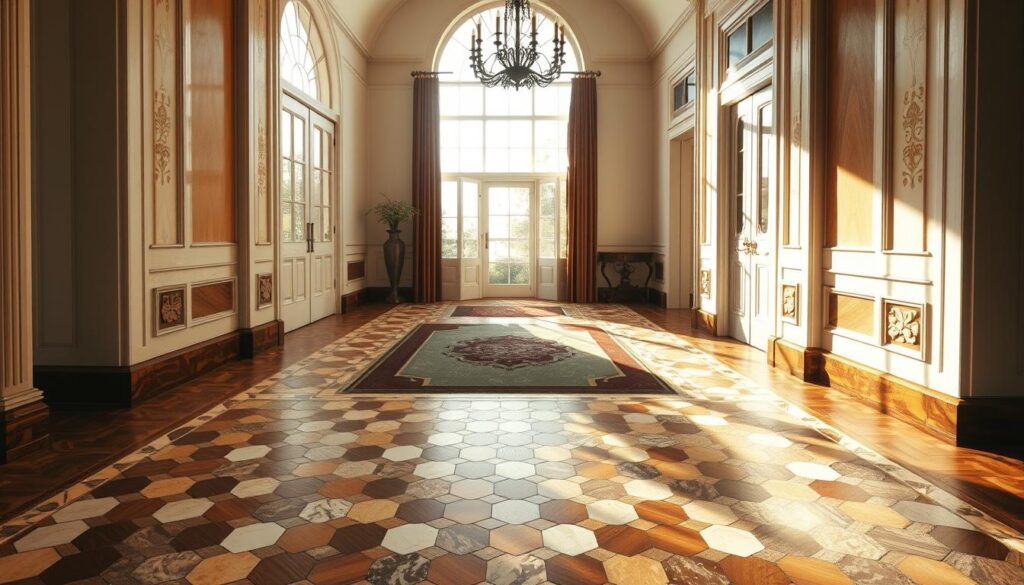
Emphasis on Area Rugs and Carpets
Area rugs and carpets were key in 1920s interior design. They added warmth, texture, and color to rooms. Popular designs included geometric shapes, florals, and abstract patterns, often in soft colors that matched the era’s furniture and decor.
Characteristics of 1920s Area Rugs and Carpets:
| Material | Pattern | Color Palette |
|---|---|---|
| Wool, Silk | Geometric, Floral, Abstract | Muted tones, Earthy colors |
| Often handmade or crafted with traditional techniques, adding to their unique charm. | ||
Maintaining and Restoring Original Floors
For those wanting to restore their 1920s home, keeping the original floors is vital. This means fixing damaged hardwood, refinishing terrazzo, or making new linoleum patterns.
Tips for Restoration:
- Check your original flooring’s condition to decide the best restoration method.
- Use traditional materials and methods to keep it authentic.
- Think about getting professional help if you’re not sure about the restoration.
Lighting Fixtures That Set the Mood
Step into the world of 1920s interior design and you’ll see how lighting is key. The right lights can change a room, bringing back the glamour of that time.
Art Deco Lighting Styles
Art Deco lighting is all about the 1920s. It uses shapes, metals, and bold designs to add luxury. Chandeliers and sconces with fancy details were big, lighting up rooms and adding style.
To bring Art Deco lighting into your home, look for pieces with geometric patterns, bold colors, and metallic accents. These will make your home feel like it’s from the 1920s.
Importance of Natural Light
Natural light was also important in 1920s homes. Big windows and fancy drapes let in lots of light. This made rooms feel bigger and more inviting. Use sheer curtains or blinds to let in sunlight.
Modern Lighting Solutions for Vintage Homes
Updating lighting in old homes can be tricky. But, you can mix old charm with new tech. Try LED candles or smart light bulbs for easy control and energy savings. Make sure new lights fit with your home’s style.
By mixing old and new, you can make a space that’s both true to its past and modern. Whether you love Art Deco or natural light, the right lights will make your 1920s home feel just right.
Wall Treatments and Textures
Wall treatments in 1920s homes were more than just practical. They showed off the era’s design trends and cultural influences. When decorating a vintage home, picking wall treatments that fit the period is key to keeping the space authentic.
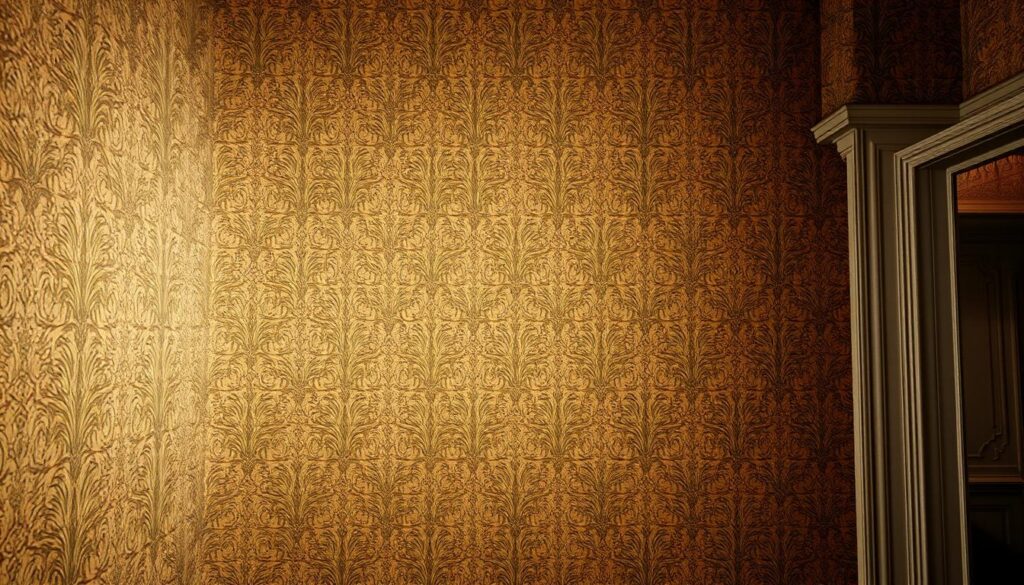
Embracing Wallpaper Trends
Wallpaper was a big deal in 1920s interior design. It came in many patterns and designs, changing a room’s feel. Geometric patterns, floral motifs, and metallic accents were favorites, bringing luxury and sophistication.
To bring this trend into your home, look for wallpapers that match the era’s bold designs and rich colors. We suggest checking out historical reproductions or modern takes that capture the 1920s style.
Techniques for Adding Texture
In the 1920s, adding texture to walls was a way to make rooms more interesting. People used plasterwork, paneling, and textured finishes to create unique interiors.
If you want to add texture, think about using materials and techniques from the 1920s. Venetian plaster or wooden paneling can give your walls an authentic look.
Common Decorative Finishes
Decorative finishes were big in 1920s wall treatments. Techniques like glazing and faux finishing added elegance. These finishes made rooms look more expensive without the high cost.
When picking decorative finishes for your vintage home, choose ones that match your space’s look. Make sure they stay true to the period.
Creating a Functional 1920s Layout
The secret to a great historic home renovation is keeping the original design but making it modern.
Understanding the 1920s layout is key. It was made for a bygone era, with different needs and ways of life.
Importance of Room Flow and Functionality
A good layout is crucial for a functional home.
The 1920s layout might not fit today’s lifestyle.
Changing the layout to improve room flow makes the home more livable.
Older homes often have small, divided rooms. This can make the space feel tight and disconnected.
To fix this, consider removing walls that don’t carry weight. This makes the living area more open.
This change also lets more natural light in, improving the home’s feel.
But, always check the walls’ strength before making changes.
Updating for Modern Living Needs
Today’s living needs are different from the 1920s.
Adding modern features like big kitchens, extra bathrooms, and smart tech can greatly enhance life.
It’s about finding a balance between today’s comforts and keeping the home’s historic charm.
Maintaining Historical Integrity
When updating, it’s crucial to keep the home’s historical essence.
This means keeping original features like hardwood floors, moldings, and architectural details. These elements are what make the home special.
“Preserving the original elements of a home is not just about maintaining its historical value; it’s also about retaining its soul.”
To keep the home’s history, work with experts who know historic renovations well.
Accessorizing with the Right Decor
Accessorizing is the final touch that brings a 1920s home to life. It reflects the era’s unique style. The right accessories can elevate the space, making it feel more authentic and lived-in. We’ll explore the must-have vintage accessories, art pieces, and greenery that will make your home shine.
Vintage Accessories to Consider
Vintage accessories play a significant role in capturing the essence of 1920s homes. Start with antique furniture pieces, like intricately carved wooden chairs or ornate metalwork. Also, look for vintage clocks, antique vases, and retro-styled lighting fixtures.
When selecting vintage accessories, look for pieces that reflect the era’s opulence and glamour. Items with ornate details, metallic accents, and classic designs evoke the luxury of the Roaring Twenties.
| Accessory | Description | Era Significance |
|---|---|---|
| Vintage Clocks | Ornate clock faces, often with Roman numerals | Symbolized status and wealth |
| Antique Vases | Intricately designed, often with floral patterns | Added a touch of elegance to rooms |
| Retro Lighting Fixtures | Geometric shapes, metallic accents | Reflected the modernity of the era |
Art and Wall Hangings from the Era
Art and wall hangings are key to 1920s decor. The era saw the rise of Art Deco, celebrating geometric patterns, metallic materials, and bold colors. Hang vintage posters, prints, or paintings that reflect the era’s aesthetic.
Choose art pieces with iconic motifs like chevrons, sunbursts, and metallic accents. Framing is also crucial; opt for frames with ornate details or metallic finishes to add to the overall opulence.
Incorporating Plants and Greenery
In addition to vintage accessories and art, plants and greenery add warmth and vitality to your 1920s home. The 1920s saw a rise in indoor plants, with many homeowners incorporating them into their decor.
To bring this trend into your home, add potted plants with ornate planters or hanging baskets with lush greenery. This will not only add color but also create a cozy, inviting atmosphere.
Incorporating Technology and Modern Comforts
Updating a 1920s home with modern tech can be tricky. But, it’s doable with the right strategy. We aim to keep our homes’ historic charm while enjoying today’s comforts.
Balancing Modern Conveniences with Style
Integrating modern tech into a 1920s home requires finding a balance. We look for devices that are both useful and fit the home’s style. For example, smart thermostats can be controlled from afar and learn your preferences.
When picking modern features, think about your home’s look. For instance, if your kitchen is from the 1920s, choose appliances that look like they belong there.
Solutions for Wiring and Outlets
Old homes often have outdated wiring and not enough outlets. To fix this, you might need a pro to update the electrical system. You can also use outlet covers or retrofits that match your home’s style.
- Check your home’s electrical needs and plan wisely.
- Think about adding new outlets in key spots.
- Choose smart home devices that don’t need a lot of wiring changes.
Smart Home Features for Vintage Homes
Smart home tech can make a 1920s home more comfortable without changing its look. Features like voice-controlled lighting and automated blinds can be added without being seen.
Some great smart home features for old homes include:
| Feature | Benefit |
|---|---|
| Smart Lighting | It saves energy and lets you set the mood |
| Home Security Systems | They make your home safer and give you peace of mind |
| Automated Thermostats | They help control the temperature and save energy |
By carefully adding modern tech, we can enjoy the charm of a 1920s home with today’s comforts.
Outdoor Spaces: Garden and Porch Ideas
The charm of a 1920s home is not just inside; its gardens and porches are also captivating. These outdoor spaces greatly enhance the home’s overall look.
Designing a Classic 1920s Garden
Creating a garden for a 1920s home means embracing symmetry and formal layouts. Gardens were often designed with geometric patterns, featuring plants like roses, lavender, and boxwood. To achieve this look, mix flowering plants and hedges in a symmetrical pattern.
Importance of Outdoor Living Areas
Outdoor living areas were key in 1920s homes, extending the indoor space. They were for relaxation, entertainment, and socializing. The porch, in particular, was a favorite feature, often set up with comfy seating and decor.
Furniture Styles for Patios and Porches
Furniture for patios and porches should match the home’s vintage look. Wicker furniture, wooden benches, and metal garden furniture with detailed designs are popular. Here’s a look at different furniture styles for 1920s outdoor spaces:
| Furniture Style | Characteristics | Best Use |
|---|---|---|
| Wicker Furniture | Lightweight, woven material | Porches and patios |
| Wooden Benches | Durable, natural look | Gardens and pathways |
| Metal Garden Furniture | Intricate designs, durable | Formal gardens and patios |
By using these elements, homeowners can make outdoor spaces that match their 1920s home’s decor. These spaces become serene and inviting.
Final Touches: Making It Your Own
As we wrap up our guide to decorating 1920 homes, it’s key to make your space unique. You should add your personal touch while keeping the era’s design in mind. Mix period-appropriate interiors with modern style by adding retro touches that show off your personality.
Adding a Personal Touch
To make your 1920s home stand out, add decorative items that match your style. Think about vintage accessories, artwork, or unique furniture that fits the era’s look.
Balancing Style and Integrity
When updating your 1920s home, balance modern comforts with historical integrity. Add modern conveniences in a way that doesn’t mess with the era’s feel.
By embracing your 1920s home’s charm and adding your personal style, you create a special living space. It honors the past and welcomes the present.

